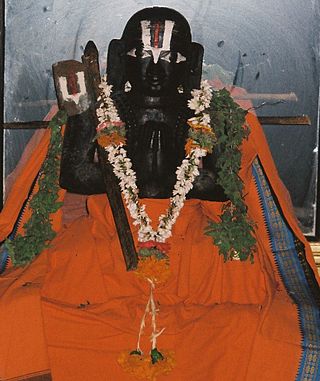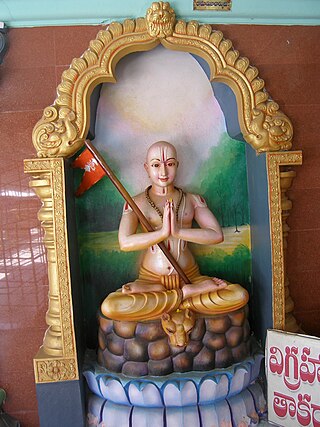
Adi Shankara, also called Adi Shankaracharya, was an Indian Vedic scholar, philosopher and teacher (acharya) of Advaita Vedanta. Reliable information on Shankara's actual life is scanty, and his true impact lies in his "iconic representation of Hindu religion and culture," despite the fact that most Hindus do not adhere to Advaita Vedanta. Tradition also portrays him as the one who reconciled the various sects with the introduction of the Pañcāyatana form of worship, the simultaneous worship of five deities – Ganesha, Surya, Vishnu, Shiva and Devi, arguing that all deities were but different forms of the one Brahman, the invisible Supreme Being.
Vedanta, also known as Uttara Mīmāṃsā, is one of the six orthodox (āstika) traditions of textual exegesis and Hindu philosophy. The word "Vedanta" means "conclusion of the Vedas", and encompasses the ideas that emerged from, or aligned and reinterpreted, the speculations and enumerations contained in the Upanishads, focusing, with varying emphasis on devotion and knowledge, and liberation. Vedanta developed into many traditions, all of which give their specific interpretations of a common group of texts called the Prasthānatrayī, translated as "the three sources": the Upanishads, the Brahma Sutras and the Bhagavad Gita.

Advaita Vedanta is a Hindu tradition of textual exegesis and philosophy which states that jivatman, the individual experiencing self, is ultimately pure awareness mistakenly identified with body and the senses, and non-different from Ātman-Brahman, the highest Self or Reality. The term Advaita literally means "non-secondness", but is usually rendered as "nondualism", and often equated with monism. It rejects the Samkhya-dualism between Purusha, pure awareness or consciousness, and Prakriti as the two equal basic principles of existence. Instead, it proposes that Atman-Brahman alone is ultimately real, and, though unchanging, the cause and origin of the transient phenomenal world (prakriti). In this view, the jivatman or individual self is a mere reflection or limitation of singular Ātman in a multitude of apparent individual bodies. It regards the material world as an illusory appearance (maya) or "an unreal manifestation (vivarta) of Brahman," the latter as proposed by the 13th century scholar Prakasatman.
Dvaita Vedanta ;, is a sub-school in the Vedanta tradition of Hindu philosophy. The term Tattvavada literally means "arguments from a realist viewpoint". The Tattvavada (Dvaita) Vedanta sub-school was founded by the 13th-century Indian philosopher-saint Madhvacharya. Madhvacharya believed in three entities: God, jiva (soul), and jada. The Dvaita Vedanta school believes that God and the individual souls (jīvātman) exist as independent realities, and these are distinct, being said that Vishnu (Narayana) is independent (svatantra), and Souls are dependent (paratantra) on him.
Vishishtadvaita is a school of Hindu philosophy belonging to the Vedanta tradition. Vedanta refers to the profound interpretation of the Vedas based on Prasthanatrayi. Vishishta Advaita, meaning "non-duality with distinctions", is a non-dualistic philosophy that recognizes Brahman as the supreme reality while also acknowledging its multiplicity. This philosophy can be characterized as a form of qualified monism, attributive monism, or qualified non-dualism. It upholds the belief that all diversity ultimately stems from a fundamental underlying unity.

Ramanuja, also known as Ramanujacharya, was an Indian Hindu philosopher, guru and a social reformer. He is noted to be one of the most important exponents of the Sri Vaishnavism tradition within Hinduism. His philosophical foundations for devotionalism were influential to the Bhakti movement.
The Brahma Sūtras, also known as the Vedanta Sūtra, Shariraka Sūtra, and Bhikshu-sūtra, are a Sanskrit text which criticizes the metaphysical dualism of the influential Samkhya philosophy, and instead synthesizes and harmonizes divergent Upanishadic ideas and practices about the essence of existence, postulating God-like Brahman as the only origin and essence of everything. It is attributed to the sages Bādarāyaṇa, who is also called Vyāsa (arranger), but probably an accumulation of incremental additions and changes by various authors to an earlier work, completed in its surviving form in approx. 400–450 CE. The oldest version may be composed between 500 BCE and 200 BCE, with 200 BCE being the most likely date.

Gauḍapāda, also referred as Gauḍapādācārya, was an early medieval era Hindu philosopher and scholar of the Advaita Vedanta school of Hindu philosophy. While details of his biography are uncertain, his ideas inspired others such as Adi Shankara who called him a Paramaguru.

Radha-Krishna is the combined form of the Hindu god Krishna with his chief consort and shakti Radha. They are regarded as the feminine as well as the masculine realities of God, in several Krishnaite traditions of Vaishnavism.
Bhedābheda is more a tradition than a sub-school of Vedānta, which teaches that the individual self (jīvātman) is both different and not different from the ultimate reality known as Brahman.

Vaishnavism is one of the major Hindu denominations along with Shaivism, Shaktism, and Smartism. It is also called Vishnuism since it considers Vishnu as the sole supreme being leading all other Hindu deities, that is, Mahavishnu. Its followers are called Vaishnavites or Vaishnavas, and it includes sub-sects like Krishnaism and Ramaism, which consider Krishna and Rama as the supreme beings respectively. According to a 2010 estimate by Johnson and Grim, Vaishnavism is the largest Hindu sect, constituting about 641 million or 67.6% of Hindus.

Krishnaism is a term used in scholarly circles to describe large group of independent Hindu traditions—sampradayas related to Vaishnavism—that center on the devotion to Krishna as Svayam Bhagavan, Ishvara, Para Brahman, who is the source of all reality, not simply an avatar of Vishnu. This is its difference from such Vaishnavite groupings as Sri Vaishnavism, Sadh Vaishnavism, Ramaism, Radhaism, Sitaism etc. There is also a personal Krishnaism, that is devotion to Krishna outside of any tradition and community, as in the case of the saint-poet Meera Bai. Leading scholars do not define Krishnaism as a suborder or offshoot of Vaishnavism, considering it at least a parallel and no less ancient current of Hinduism.

The Nimbarka Sampradaya, also known as the Kumāra Sampradāya, Hamsa Sampradāya, and Sanakādi Sampradāya, is one of the four Vaiṣṇava Sampradāyas. It was founded by Nimbarka, a Telugu Brahmin yogi and philosopher. It propounds the Vaishnava Bhedabheda theology of Dvaitadvaita (dvaita-advaita) or dualistic non-dualism. Dvaitadvaita states that humans are both different and non-different from Isvara, God or Supreme Being. Specifically, this Sampradaya is a part of Krishnaism—Krishna-centric traditions.

The Swaminarayan Bhashyam (Svāminārāyaṇabhāṣyam) is a five-volume Sanskrit bhashya, or commentary, on the Prasthanatrayi (Prasthānatrayī) - the ten principal Upanishads (Upaniṣads), the Bhagavad Gita (Bhagavadgītā), and the Brahmasutras (Brahmasūtras) - which establishes the principles taught by Swaminarayan as perceived by the BAPS.

The Vedarthasamgraha, also rendered Vedarthasangraha, is a treatise by the Hindu philosopher Ramanuja, comprising his exegesis of a number of Upanishadic texts. The first of his three major works, Ramanuja propounds the doctrine of the Vishishtadvaita philosophy in this work and offers a discourse on the concepts of Brahman, bhakti, and moksha in Vedanta philosophy.

Harivyas devacharya (c. 15th Century, also known as Harivyasadeva was an Indian philosopher, theologian and poet. Born into a Gaud brahmin family, he became the 35th āchārya of the Nimbārka Sampradāya. Residing in the sacred town of Vrindavana, he was a disciple of Śrī Śrībhaṭṭa Devāchārya ji and his nom-de-plume was Hari Priyā.He also played a pivotal role in expanding the reach of the Nimbārka Sampradāya by sending twelve main disciples on missionary journeys across Indian Subcontinent, each establishing their own sub-lineage, some of which continue to thrive today.

Srinivasacharya also known as Srinivasa, was a vedantic philosopher and theologian. He was a disciple of Nimbārkacārya and an acharya of Nimbārka Sampradāya. Srinivasacharya composed Vedānta-Kaustubha at the request of Nimbārkacārya. Srinivasacharya's philosophical framework, known as Svabhāvika Bhedābheda, emphasizes the natural distinction and similarity between the individual soul and the supreme being.
Svābhāvika Bhedābheda, also known as Dvaitādvaita and as Bhinnābhinna, is the philosophical doctrine of "natural identity-in-difference" or "natural difference cum-non-difference." It was propagated by the medieval Vedānta scholars Nimbarkacharya and Srinivasacharya, as an explication of bhedābheda, difference and non-difference of Atman and Brahman.

Keshav Kashmiri (c. 15th Century, also known as keshavacharya and Keshava Kashmriri Bhattacharya was an Indian philosopher, theologian and poet. He was a Brāhmana, born in the province of Maharashtra, in the village named Vaidūrya-pattanam, also known as Pratiṣṭhāna. He was disciple of Mukunda and Gāṅgala bhaṭṭāchārya. He became the 33rd ācārya of the Nimbārka Sampradāya. Tradition is that he conquered thrice all learned men of his time. Hence the epithet 'Jagadvijayī is often prefixed to his name.

The Vedanta kamadhenu dashashloki is a Sanskrit hymn by the Hindu philosopher Nimbarkacharya of the Nimbarka Sampradaya tradition.














